-
Products
-
SonicPlatform
SonicPlatform is the cybersecurity platform purpose-built for MSPs, making managing complex security environments among multiple tenants easy and streamlined.
Discover More
-
-
Solutions
-
Federal
Protect Federal Agencies and Networks with scalable, purpose-built cybersecurity solutions
Learn MoreFederalProtect Federal Agencies and Networks with scalable, purpose-built cybersecurity solutions
Learn More - Industries
- Use Cases
-
-
Partners
-
Partner Portal
Access to deal registration, MDF, sales and marketing tools, training and more
Learn MorePartner PortalAccess to deal registration, MDF, sales and marketing tools, training and more
Learn More - SonicWall Partners
- Partner Resources
-
-
Support
-
Support Portal
Find answers to your questions by searching across our knowledge base, community, technical documentation and video tutorials
Learn MoreSupport PortalFind answers to your questions by searching across our knowledge base, community, technical documentation and video tutorials
Learn More - Support
- Resources
- Capture Labs
-
- Company
- Contact Us
How to configure site to site VPN policy using Main Mode on NSSP 13700 ?



Description
This article details how to configure a Site-to-Site VPN using Main Mode, which requires the SonicWall and the Remote appliance (SonicWall or Non-SonicWall) to both have Static Public IP Addresses.
Resolution
 NOTE: During the initial release, NSSP 13700 is only available in global mode. In a later release, SonicOSX with Policy mode will be available for selection.
NOTE: During the initial release, NSSP 13700 is only available in global mode. In a later release, SonicOSX with Policy mode will be available for selection.
Step 1: Creating the necessary Address Objects
- Login to the SonicWall GUI.
- Click Object in the top navigation menu.
- Click Match Objects | Addresses.
- Click Add and create an address object for VPN Zone, Type as Network for the remote site LAN subnet on Site A.
- Click Save to add the Address Object to SonicWall's Address Object Table.
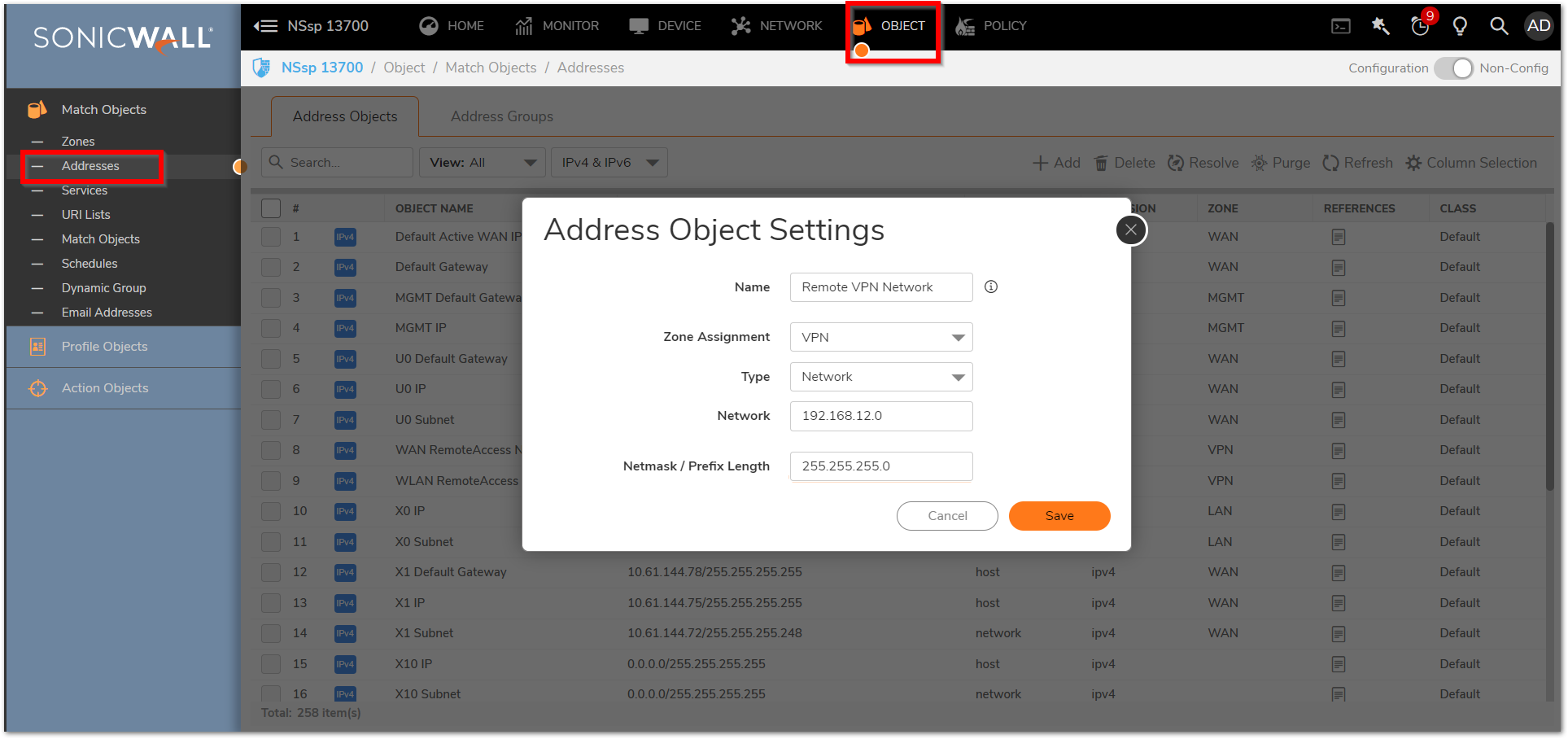
Similarly we need to create the Address object On Site B as shown below:
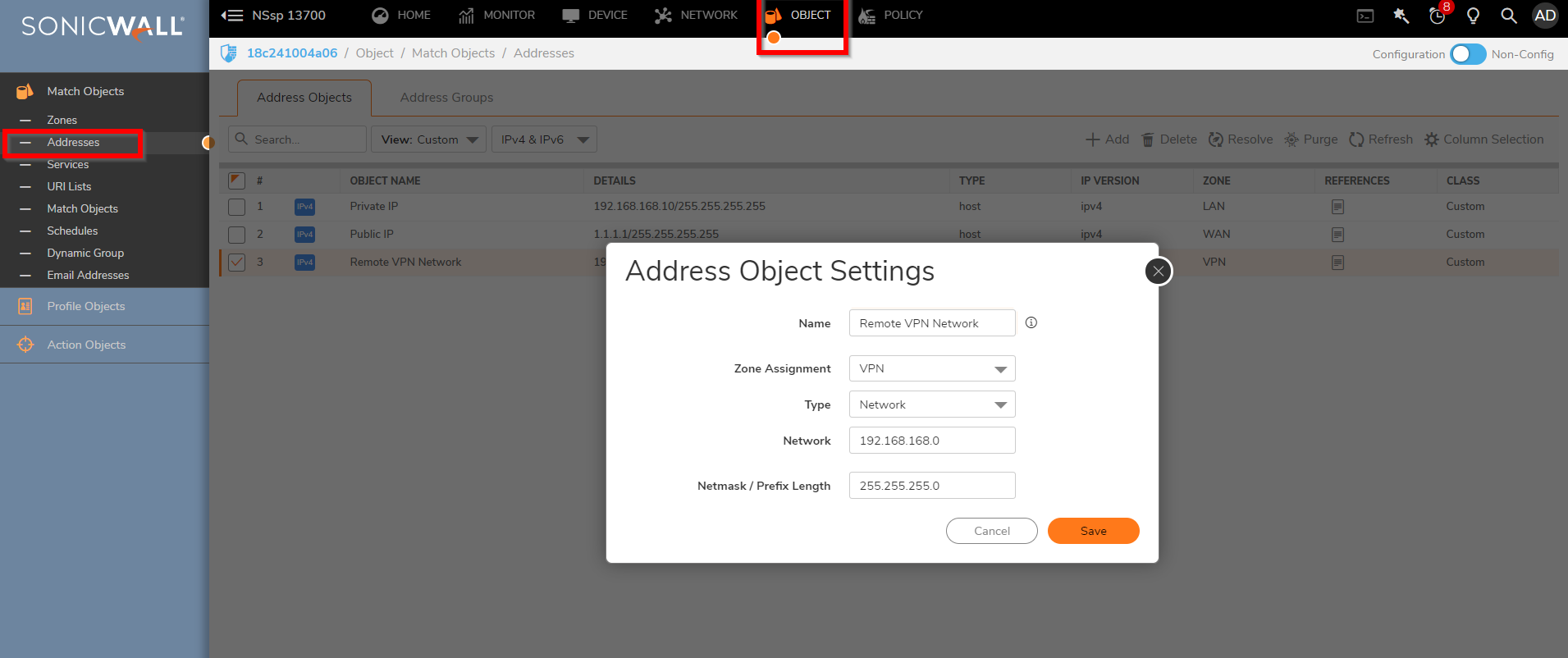
Configuring a VPN policy on Site A SonicWall
- Click Network in the top navigation menu.
- Navigate to IPSec VPN | Rules and Settings,click Add. The VPN policy window is displayed.
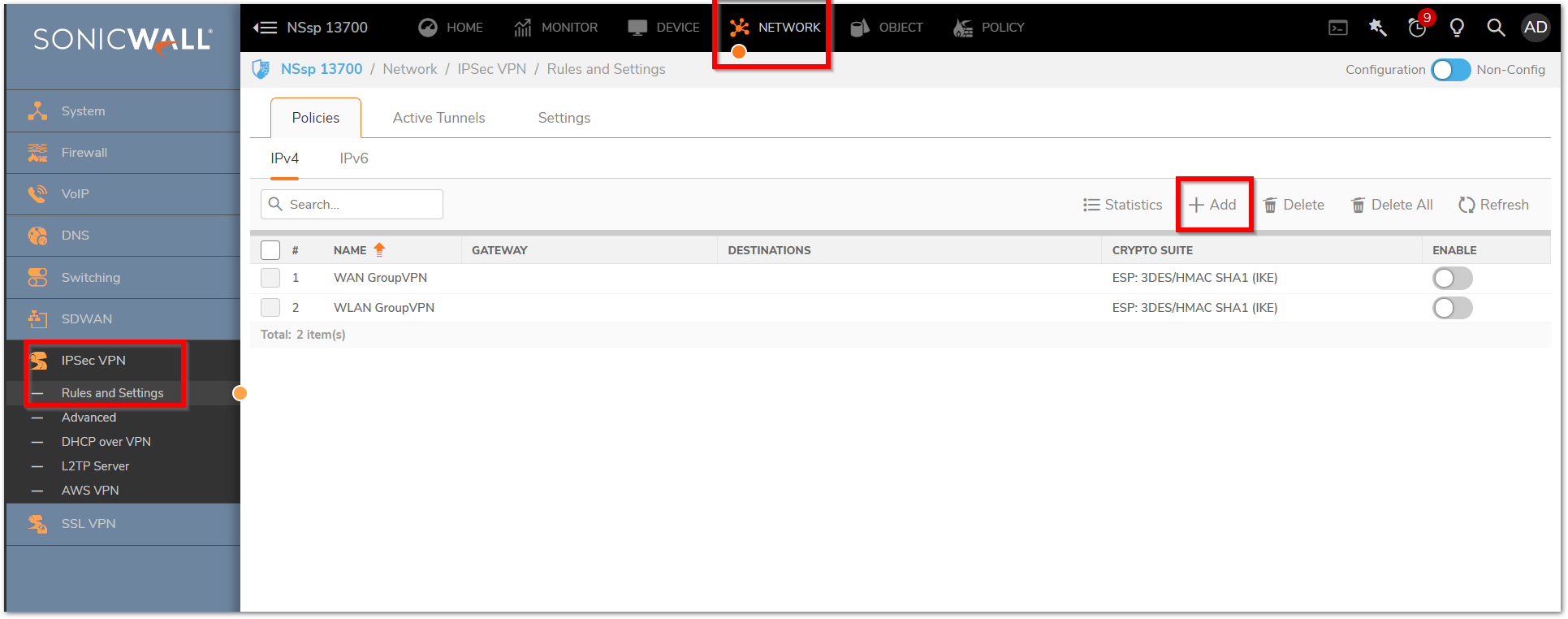
Click General tab.
- Select IKE using Preshared Secret from the Authentication Method menu.
- Enter a name for the policy in the Name field.
- Enter the WAN IP address of the remote connection in the IPSec Primary GatewayName or Address field (Enter Remote NSSP 13700 address).
 TIP: If the Remote VPN device supports more than one endpoint, you may optionally enter a second host name or IP address of the remote connection in the IPSec Secondary Gateway Name or Address field.
TIP: If the Remote VPN device supports more than one endpoint, you may optionally enter a second host name or IP address of the remote connection in the IPSec Secondary Gateway Name or Address field. - Enter a Shared Secret password to be used to setup the Security Association the Shared Secret and Confirm Shared Secret fields. The Shared Secret must be at least 4 characters long, and should comprise both numbers and letters.
- Optionally, you may specify a Local IKE ID (optional) and Peer IKE ID (optional) for this Policy.

Click Network Tab.
- Under Local Networks, select a local network from Choose local network from list: and select the address object (X0 Subnet).
-
Under Destination Networks, select Choose destination network from list: and select the address object (Remote VPN Network)
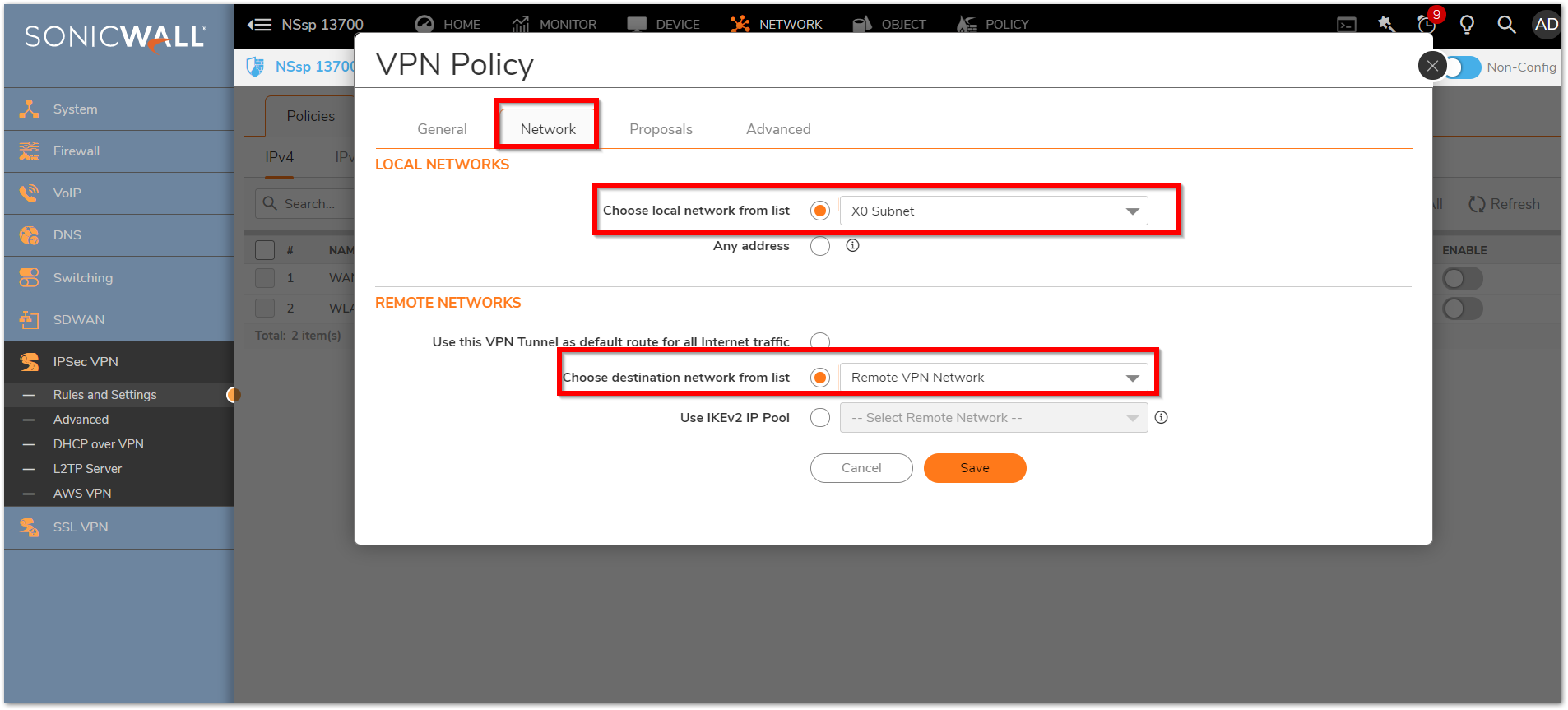
Click the Proposals Tab
- Under IKE (Phase 1) Proposal, select Main Mode from the Exchange menu.
- Under IKE (Phase 1) Proposal, the default values for DH Group, Encryption, Authentication, and Life Time are acceptable for most VPN configurations. Be sure the Phase 1 values on the opposite side of the tunnel are configured to match.
- Under IPSec (Phase 2) Proposal, the default values for Protocol, Encryption, Authentication, Enable Perfect Forward Secrecy, DH Group, and Lifetime are acceptable for most VPN SA configurations. Be sure the Phase 2 values on the opposite side of the tunnel are configured to match.
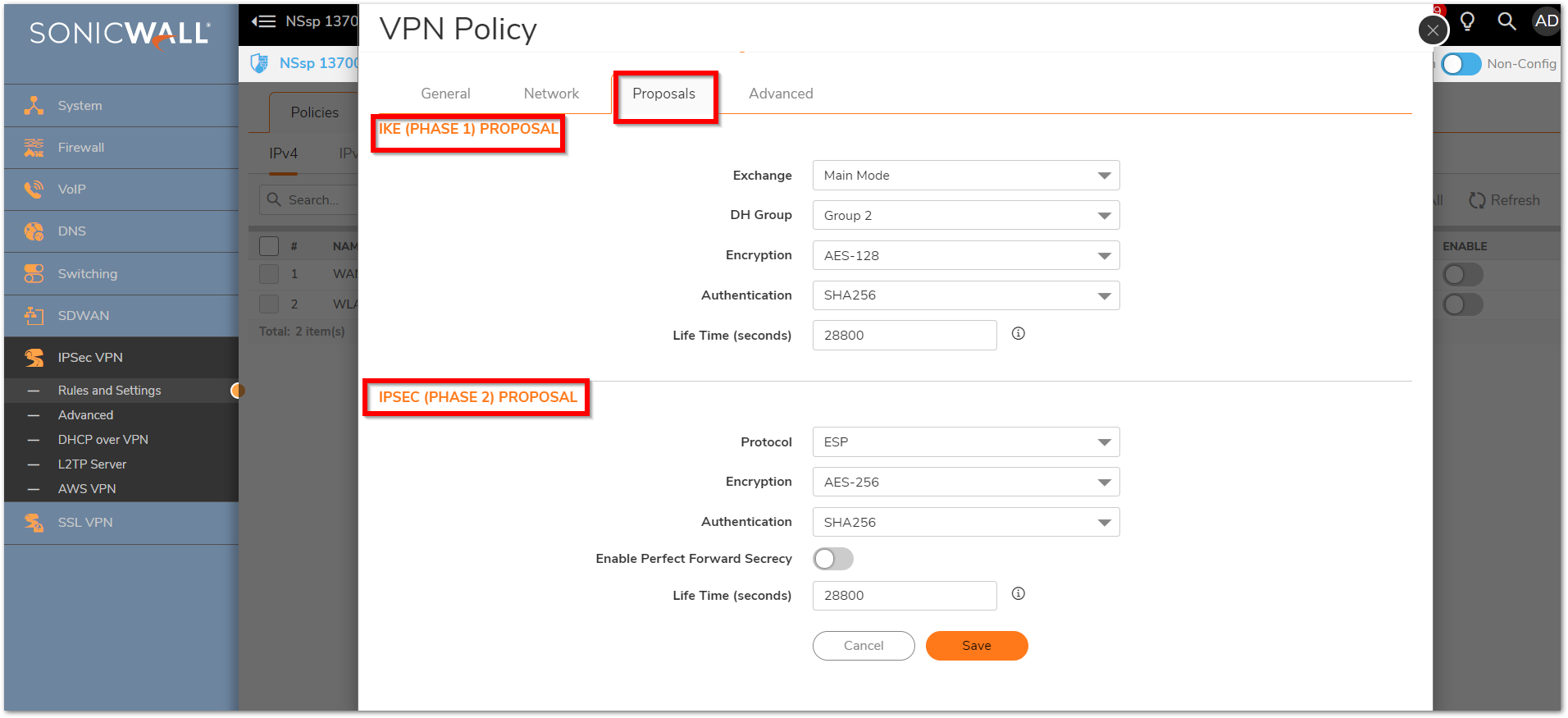
Click Advanced tab.
- Select Enable Keep Alive to use heartbeat messages between peers on this VPN tunnel. If one end of the tunnel fails, using Keepalives will allow for the automatic renegotiation of the tunnel once both sides become available again without having to wait for the proposed Life Time to expire.
- Select Enable Windows Networking (NetBIOS) Broadcast to allow access to remote network resources by browsing the Windows® Network Neighborhood.
- Select Enable Multicast to allow IP multicasting traffic, such as streaming audio (including VoIP) and video applications, to pass through the VPN tunnel.
- Select Permit Acceleration to enable redirection of traffic matching this policy to the WAN Acceleration (WXA) appliance.
- To manage the local SonicWall through the VPN tunnel, select HTTP, HTTPS, or both from Management via this SA. Select HTTP, HTTPS, or both in the User login via this SA to allow users to login using the SA.
- If you wish to use a router on the LAN for traffic entering this tunnel destined for an unknown subnet, for example, if you configured the other side to Use this VPN Tunnel as default route for all Internet traffic, you should enter the IP address of your router into the Default LAN Gateway (optional) field.
- Select an interface or zone from the VPN Policy bound to menu. A Zone WAN is the preferred selection if you are using WAN Load Balancing and you wish to allow the VPN to use either WAN interface.
- Click Save.
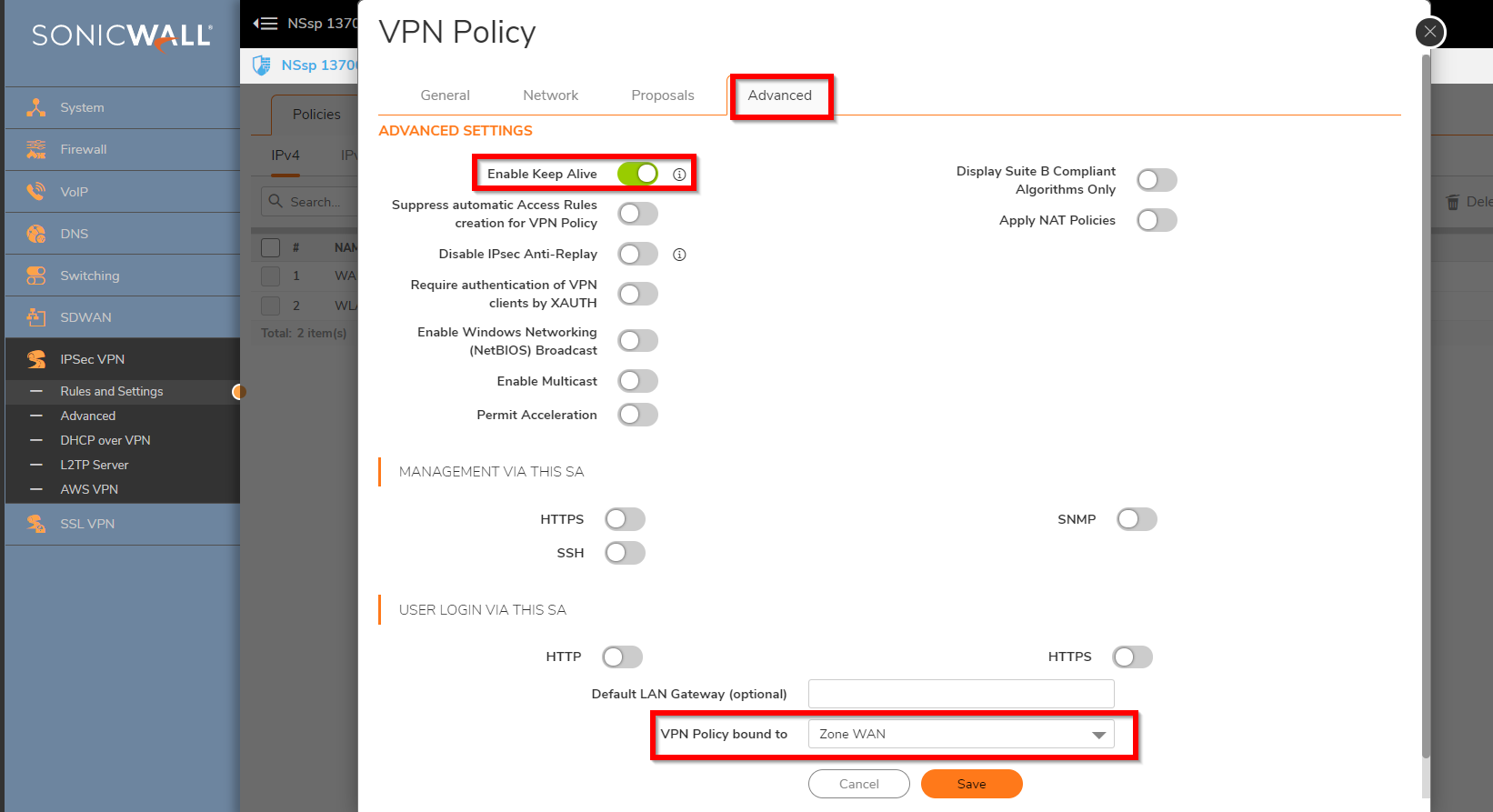
Configuring a VPN policy on Site B SonicWall
- Click Network in the top navigation menu.
- Navigate to IPSec VPN | Rules and Settings,click Add. The VPN policy window is displayed.
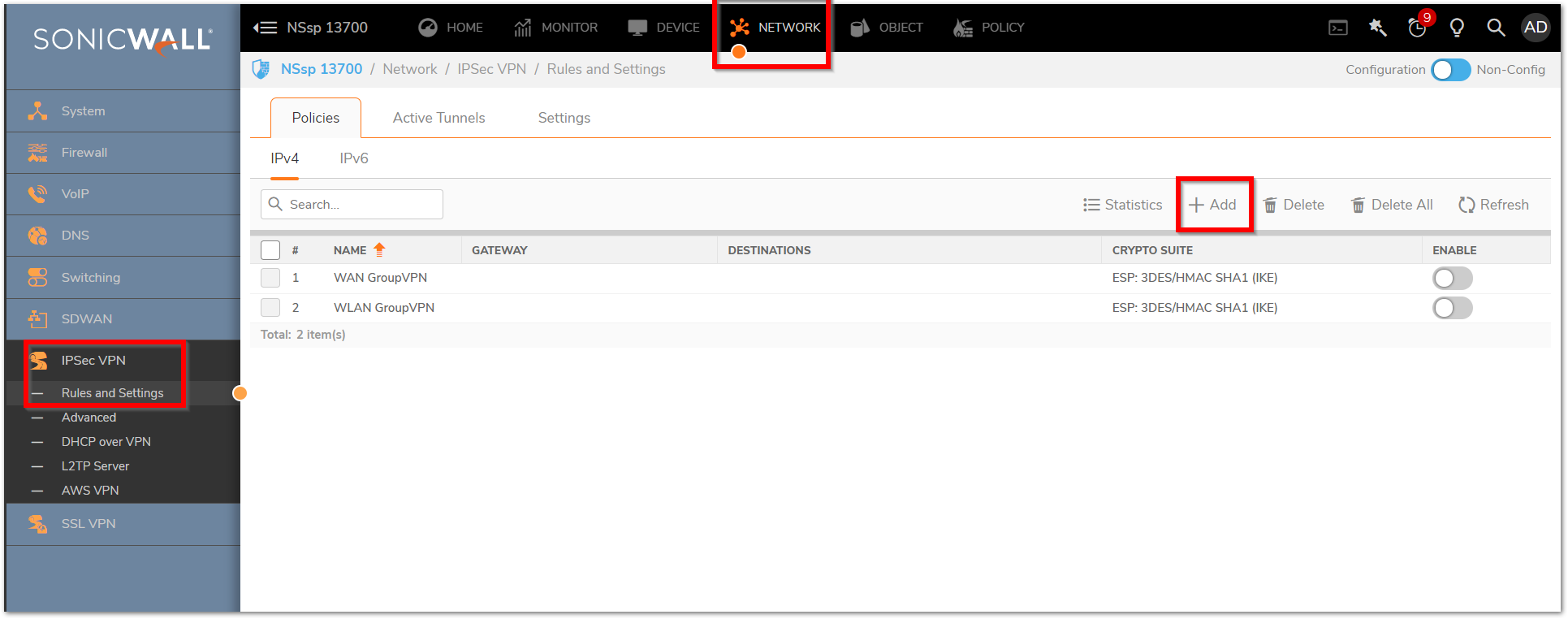
Click General tab.
- Select IKE using Preshared Secret from the Authentication Method menu.
- Enter a name for the policy in the Name field.
- Enter the WAN IP address of the remote connection in the IPSec Primary GatewayName or Address field (Enter Remote NSSP 13700 WAN IP address).
 TIP: If the Remote VPN device supports more than one endpoint, you may optionally enter a second host name or IP address of the remote connection in the IPSec Secondary Gateway Name or Address field.
TIP: If the Remote VPN device supports more than one endpoint, you may optionally enter a second host name or IP address of the remote connection in the IPSec Secondary Gateway Name or Address field. - Enter a Shared Secret password to be used to setup the Security Association the Shared Secret and Confirm Shared Secret fields. The Shared Secret must be at least 4 characters long, and should comprise both numbers and letters.
- Optionally, you may specify a Local IKE ID (optional) and Peer IKE ID (optional) for this Policy.

Click Network Tab.
- Under Local Networks, select a local network from Choose local network from list: and select the address object X0 Subnet .
-
Under Destination Networks, select Choose destination network from list: and select the address object Remote VPN Network
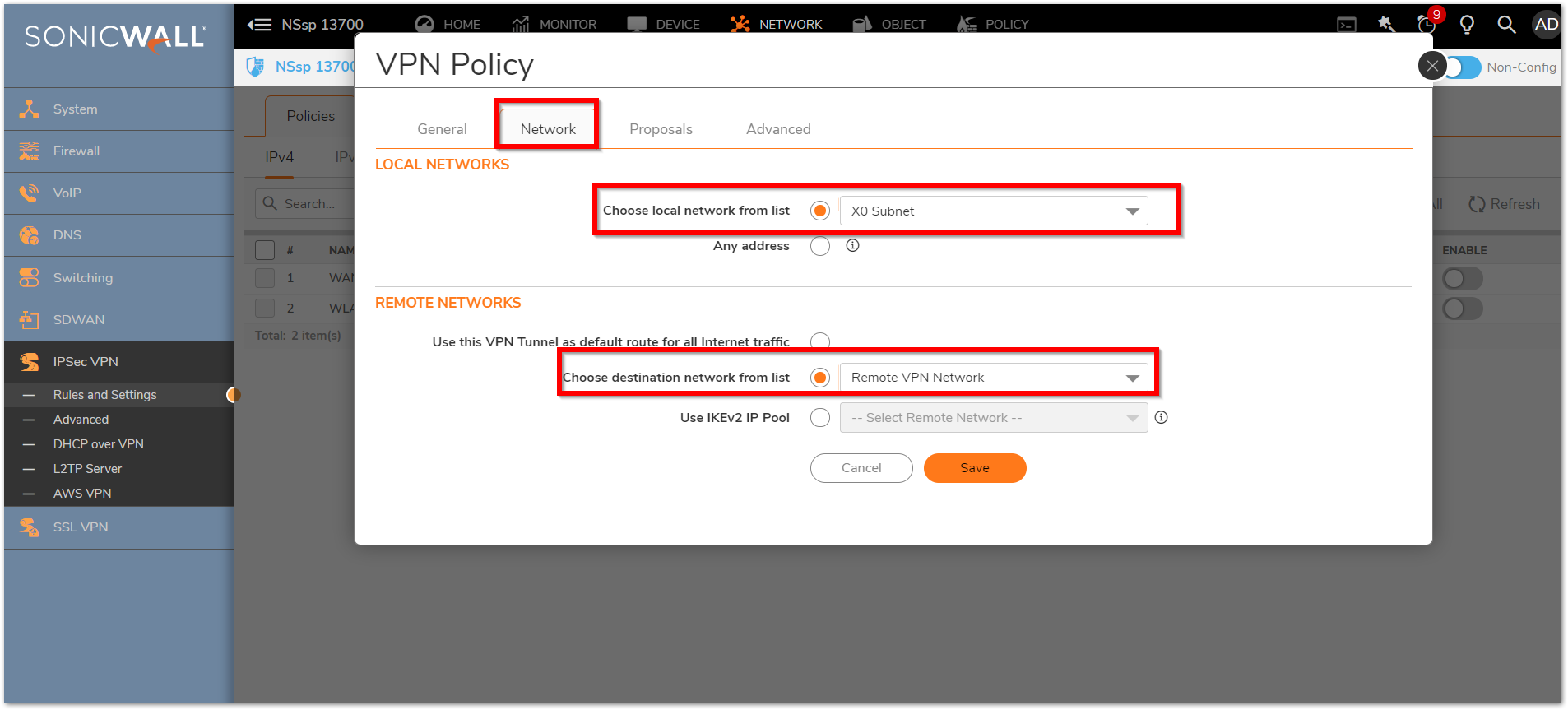
Click the Proposals tab.
 NOTE: Must have the same settings as the Site A.
NOTE: Must have the same settings as the Site A.
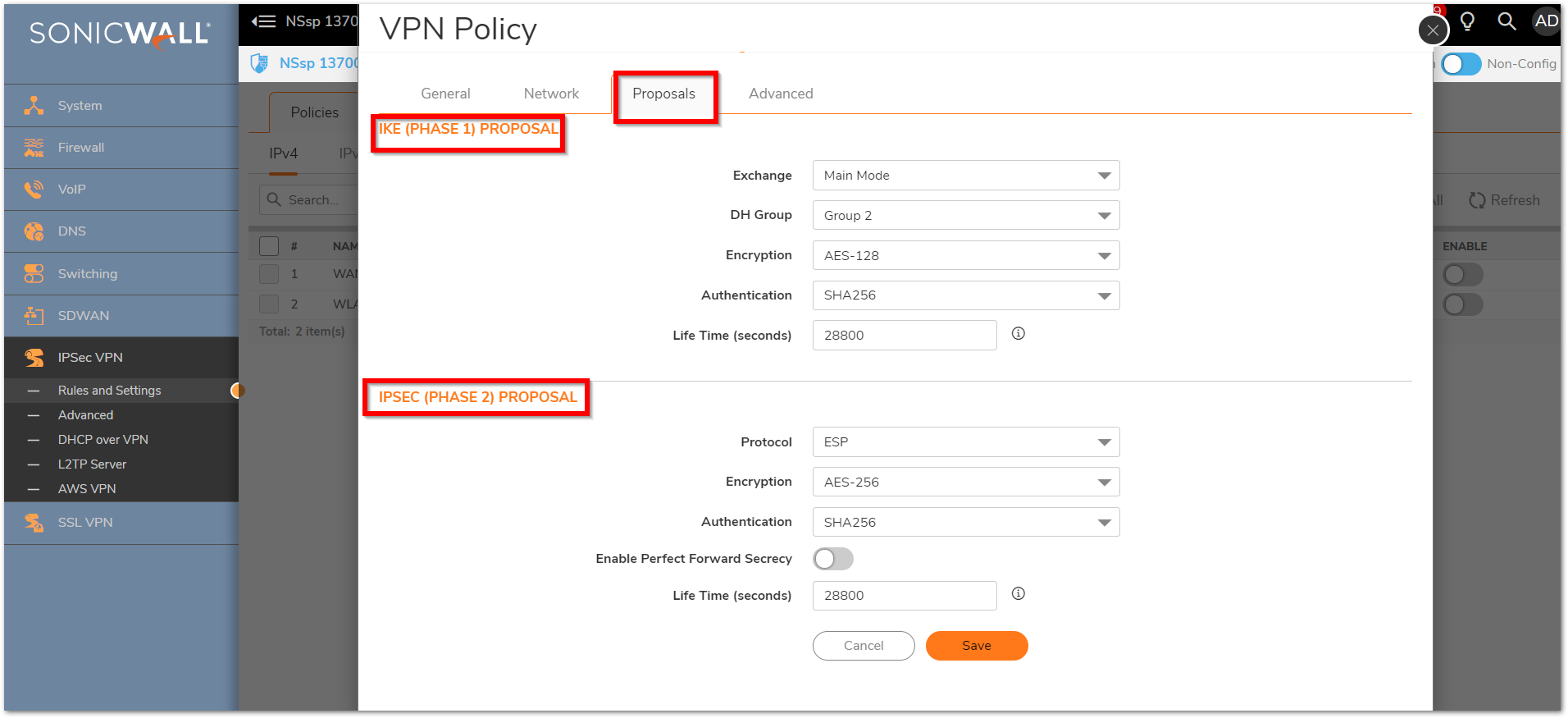
Click on the Advanced tab
- Select Enable Keep-Alive to use heartbeat messages between peers on this VPN tunnel. If one end of the tunnel fails, using Keep alives will allow for the automatic
- renegotiation of the tunnel once both sides become available again without having to wait for the proposed Life Time to expire.
- Select Enable Windows Networking (NetBIOS) Broadcast to allow access to remote network resources by browsing the Windows® Network Neighborhood.
- To manage the local SonicWall through the VPN tunnel, select HTTP, HTTPS, or both from Management via this SA. Select HTTP, HTTPS, or both in the User login via this SA to allow users to login using the SA.
- If you wish to use a router on the LAN for traffic entering this tunnel destined for an unknown subnet, for example, if you configured the other side to Use this VPN Tunnel as default route for all Internet traffic, you should enter the IP address of your router into the Default LAN Gateway (optional) field.
- - Select an interface or zone from the VPN Policy bound to menu. A Zone WAN is the preferred selection if you are using WAN Load Balancing and you wish to allow the VPN to use either WAN interface.
- Click OK.
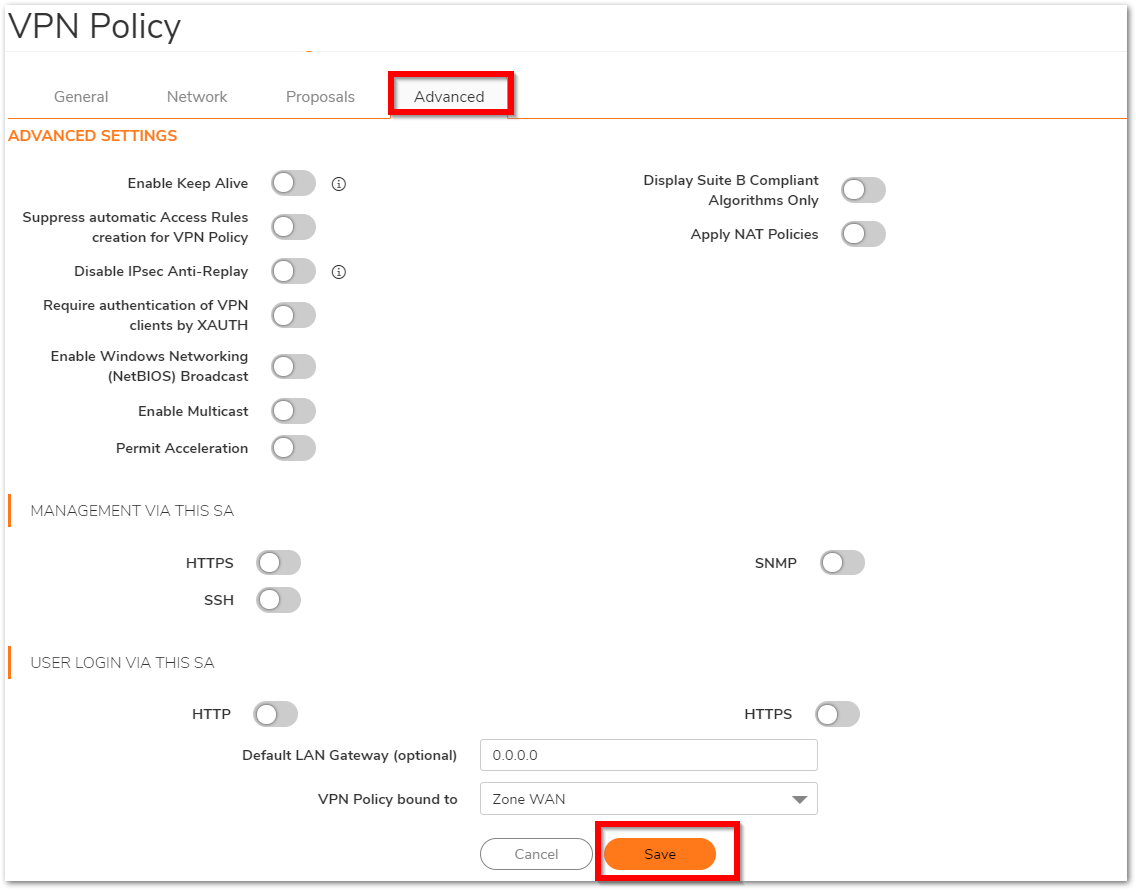
The Tunnel Status will be displayed:

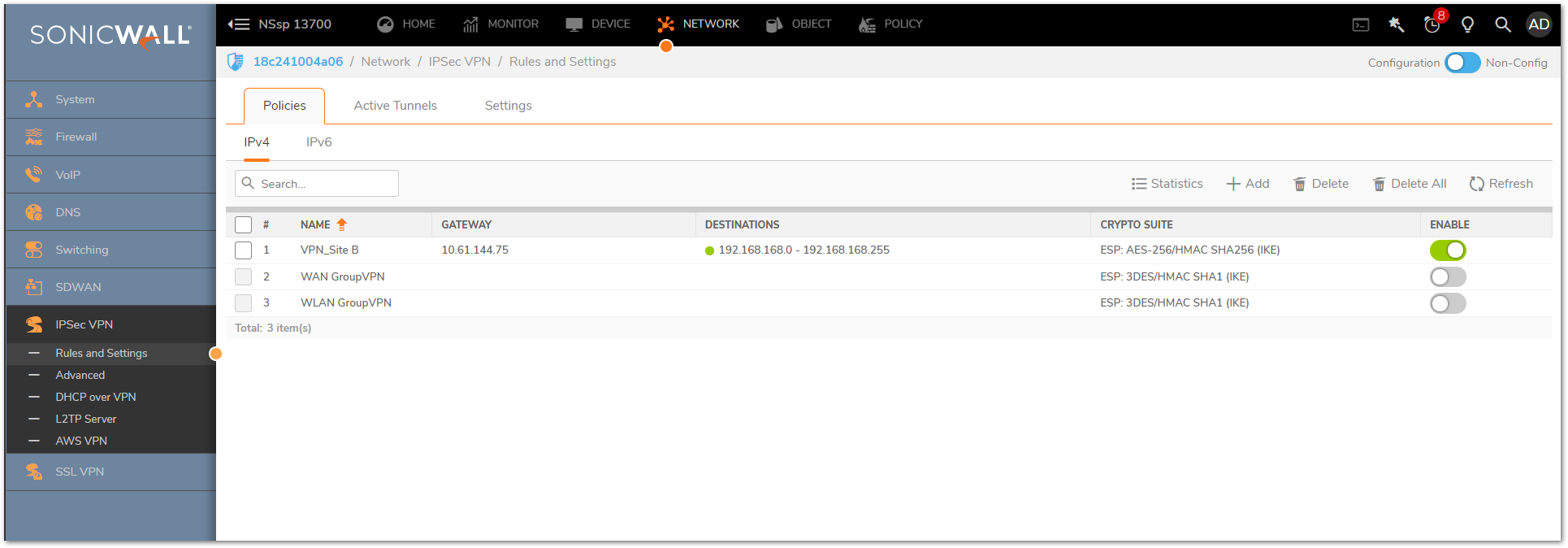
Related Articles
- How to re-deploy a NSv in the existing resource group in azure platform
- How to access a more specific network over VPN tunnel while having another Route All VPN policy
- How to limit bandwidth usage when playing YouTube videos using App Rules
Categories
- Firewalls > NSsp Series > VPN






 YES
YES NO
NO